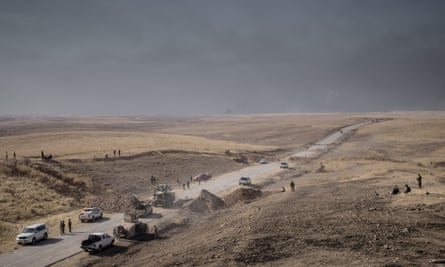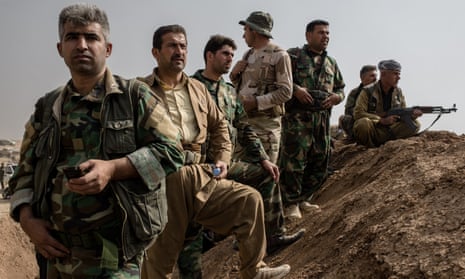At the edge of the Nineveh plains, where hundreds of thousands of Iraqis from ethnic and religious minorities were forced to flee more than two years ago, the Kurdish peshmerga were massing. Ahead was an area they had long controlled – until they were forced out by Islamic State’s lightning assault in August 2014.
That rout marked the end of several millennia of coexistence in northern Iraq, and the ignominy has burned ever since. On Thursday, the peshmerga returned with a vengeance.
Standing on the edge of the straw-coloured plains, with a patchwork quilt of Christian, Shabak, Yazidi and Turkmen communities in front of them, Kurdish officers said they would never again retreat as they had when the Isis onslaught changed the face of modern Iraq.
Officers and soldiers alike knew that winning back the plains would be a lot harder than losing them. All morning, columns of cars carrying peshmerga fighters snaked towards three frontlines north of Mosul. And all morning they were targeted with mortars and rifle fire.
At the Bashiqa front, Isis militants in the first village waited in hiding as hundreds of peshmerga advanced, taking a giant trench and an earth berm that the Islamists had dug as a defensive measure. Now the berm was being used to attack them.
The only sign that Isis was on the alert was the now-ubiquitous oil fires, which insurgents light every time the group comes under attack. Their purpose is to make it difficult for warplanes to spot them below – but that was not working on Thursday. As the black smoke unfurled a canopy over the battlefield, jets roared above and bombs thudded on the grey buildings ahead.
The Kurds moved forward to a point just outside the village – and then came the Isis counter-attack. First, a hail of heavy machine-gun fire, then the giant flame of a powerful car bomb, and then, a full four seconds later, the blast.

Soon, the peshmerga were withdrawing. Cars bearing the dead and dying bounced across the fields, their horns honking frantically. As the wounded were evacuated to ambulances on a nearby main road, a British man in military uniform stood behind a machine gun on a pickup truck, which moved towards the fire.
He would not say where he was from, and insisted that his face should not be photographed. But alongside him were an array of weapons typically carried by Special Forces. The British and Australian SAS are active in northern Iraq, along with US forces, where they have been calling in airstrikes to support both Kurdish and Iraqi advances. Their role at the frontline has not been well documented, however. Peshmerga officers said the New Zealand SAS are also present. The NZ defence minister said it was incorrect to say NZ SAS were calling in airstrikes or involved in other combat operations in Iraq, NZ media reported.
As the Kurdish evacuated their wounded, an elder standing on the earth berm implored others to advance. “You are noble, you have honour – and you are fighting for a cause,” he shouted, as rifle fire crackled in the near distance. The peshmerga huddled tighter into the berm as the old man shouted: “This is a merciless enemy and you have a long history as fighters, as men. Go forward!”

Beyond the first village, lay the towns of Bashiqa and Bahzani, and others that must be captured before the offensive links up with the Iraqi army, which is advancing from the south and south-east. Iraqi officers said they had surrounded the largest Christian city in Iraq, Hamdaniya, about 30 miles from Mosul.
Hamdaniya is seen as a prize by both Iraqi and Kurdish forces. Its fate is central to whether minorities can safely return to Nineveh and whether a region that was a haven of coexistence can reclaim that status. Iraqi officers said they had seized the town of Bartella on Thursday night, as the battle ground slowly into the fourth day of a campaign that could last for up to two months.
The principal element of that campaign is Mosul, Iraq’s second-largest city. The International Rescue Committee said it had spoken to residents inside the besieged city, who had been stockpiling white cloths to wave in surrender when anti-Isis forces eventually enter the city. The IRC also said the old and infirm were struggling to breathe properly in Mosul because of the toxic smoke of oil fires.
Peshmerga leaders have said they will not enter Mosul, leaving that role to the Iraqi army, which is anxious to use the campaign as a nation-building moment, two years after it too fled the area.
“They can have Mosul,” said one peshmerga officer, three miles behind the front. “We don’t want it. All we want is the Kurdish land that Saddam took from us. After that, we can build a real country.”
Additional reporting by Salem Rizk
